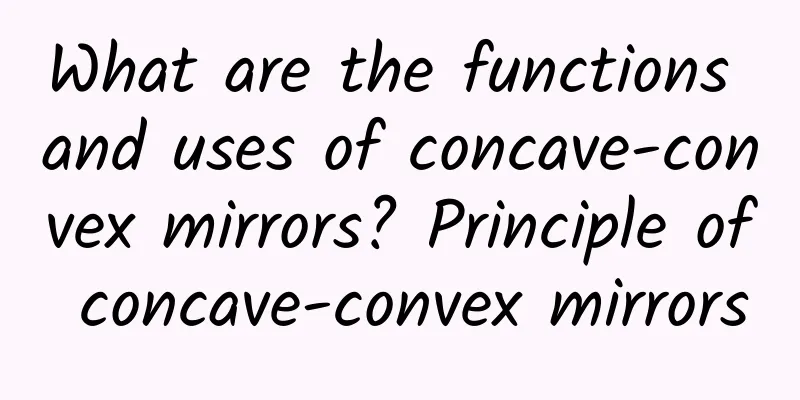What are the functions and uses of concave-convex mirrors? Principle of concave-convex mirrors

|
Concave lenses can focus light and can be used to make myopia glasses; convex lenses can disperse light and can be used to make hyperopia glasses. Concave lenses can focus light and can be used to make matches with a magnifying glass or the sun. Do you find this knowledge difficult to understand? And you don't know why it is like this? Let's learn more about it together! Contents of this article 1. The function and use of concave and convex mirror 2. How does a physical concave-convex mirror reflect? 3. Concave and convex mirror principle 1The role and use of concave and convex mirrorsConcave lenses can focus light and can be used to make myopia glasses; convex lenses can disperse light and can be used to make hyperopia glasses. Concave mirrors can focus, and you can use a magnifying glass to light a match; convex mirrors can expand the field of view. Concave and convex lenses can be used to observe distant objects. The light refracted through the lens or reflected by the concave mirror enters the small hole and converges into an image, and then is seen through a magnifying eyepiece. Therefore, a concave lens and a convex lens can form a telescope. Solar cookers, table lamps, TV satellite antennas, and radars use concave and convex mirrors to converge light. Searchlights, flashlights, and headlight covers of various motor vehicles use the light that passes through the focus to become parallel light parallel to the main axis after reflection. Concave-convex lens is a lens with a thicker central part. Convex lenses are divided into biconvex, plano-convex and concave-convex (or positive meniscus) forms. Thin convex lenses have a converging effect, so they are also called focusing lenses. Thicker convex lenses have telescopic, divergent or converging effects, which are related to the thickness of the lens. 2How does a physical concave convex mirror reflectConcave mirror: It has a convergence effect on light. The reflecting surface is the inner surface of the curved surface. During reflection, parallel light will be converged to the focus. According to the reversible principle of light path, the light emitted from the focus will be emitted in parallel. Applications: flashlights, reflective bowls of car headlights, solar cookers, etc. Convex mirror: It has a scattering effect on light. The reflecting surface is a convex surface of the curved surface. When reflecting, the parallel light is extended in the opposite direction and converges to the virtual focus. According to the reversible principle of the optical path, the light pointing to the virtual focus will be emitted in parallel. Application: car rearview mirror, etc. 3Concave and convex mirror principleTake Huawei MateBook X and win10 as an example. Imaging principle of concave lens: The concave lens forms an erect and reduced virtual image, and the object and the image are on the same side of the lens. When the object is real, an erect and reduced virtual image is formed, and the image and the object are on the same side of the lens; when the object is virtual, and the distance from the concave lens to the virtual object is within one focal length (absolute value), an erect and enlarged real image is formed, and the image and the object are on the same side of the lens. Imaging principle of convex lens: Convex lenses have a magnifying effect. Convex lenses have double focal lengths and are divided into large and small, and single focal lengths and are divided into real, virtual, positive and negative. When parallel light (such as sunlight) is incident into a convex lens parallel to the principal optical axis (the line connecting the centers of the two spherical surfaces of a convex lens is called the principal optical axis of the lens), the light is refracted twice on both sides of the lens and then concentrated at a point on the axis. This point is called the focal point of the convex lens (symbol: F, in English: focal point). The convex lens has a real focus on each side of the lens. If it is a thin lens, the distances from these two focuses to the center of the lens are roughly equal. The focal length of a convex lens refers to the distance from the focus to the center of the lens, usually expressed as f. The smaller the radius of the convex lens sphere, the shorter the focal length (symbol: f, in English: focal length). |
>>: What are the characteristics of convex lens imaging? The focal length of the convex lens
Recommend
What to cook with black chicken soup? Should I drink black chicken soup in the morning or at night?
Black chicken soup is rich in nutrients and very ...
Does the cervical cyst affect pregnancy?
Every woman should ensure the health of her repro...
What does a girl look like before and after putting on makeup? What are the steps for putting on makeup without makeup?
In ancient Egypt, people often used sesame oil an...
Will women who often stay up late have irregular menstruation?
Nowadays, there is a trend in society that many p...
Introduction to the causes of fungal vaginitis
When it comes to candidal vaginitis, women may be...
What are the recipes for nutritious postpartum meals?
Postpartum women need to secrete enough milk to m...
How to remove blackheads most effectively for women
With the development of modern society, there are...
Abdominal pain after ectopic pregnancy surgery
Ectopic pregnancy is a pregnancy that occurs outs...
A Wuhan man suffered a detached retina while playing basketball! People of this type should be especially careful
35-year-old white-collar worker in Wuhan After pl...
Causes of thyroid nodules in women
There are still many women who have thyroid nodul...
What can women eat to relieve dysmenorrhea?
Many women are prone to lower abdominal pain duri...
Chinese scientists "outline" the "blueprint" for global aging research
With the advent of the 21st century, population a...
Be careful! These habits may lead to bone loss! Learn these knowledge to keep your "hard" bones
When it comes to bone loss, many people think it ...









